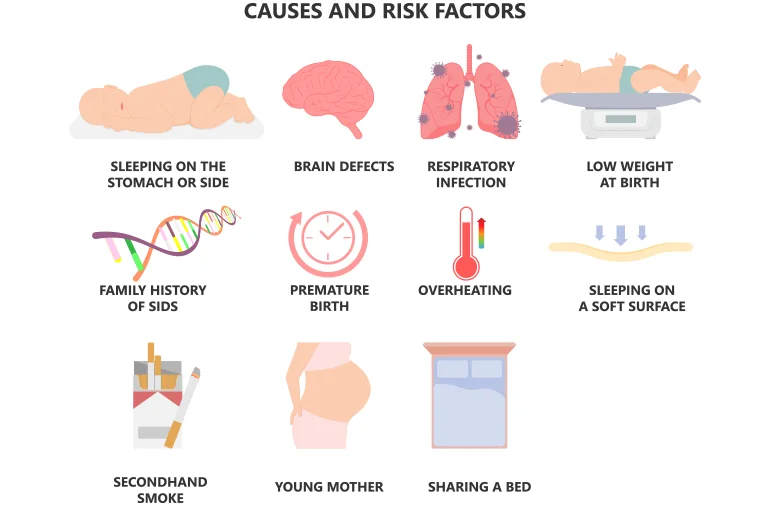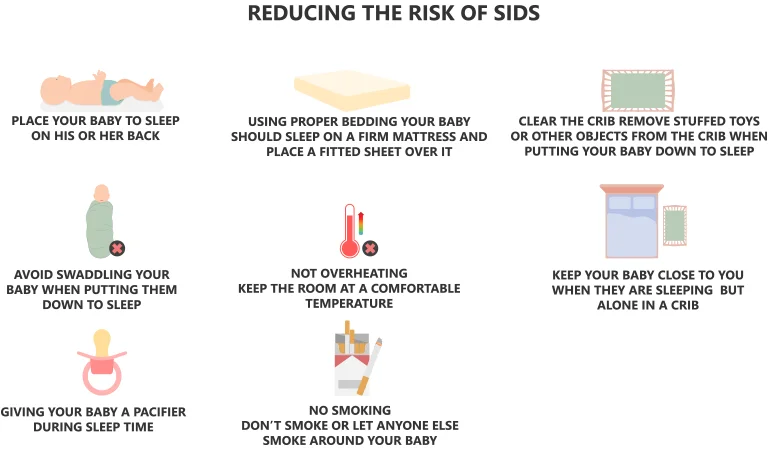Subscribe to get weekly insights
Always stay up to date with our newest articles sent direct to your inbox
Published on 25 Jul, 2025
Updated on 25 Jul, 2025
10 Views
4 min Read

Written by Sejal Singhania
Reviewed by Akhil Pillai
favorite0Like
favoriteBe the First to Like
Nothing is more heartwarming than seeing your little one peacefully asleep, calm and warm. It's a precious moment that many parents cherish deeply. However, sometimes, without warning, this peaceful sleep can turn into an unimaginable tragedy.
Sudden Infant Death Syndrome (SIDS) refers to the unexpected and unexplained death of a seemingly healthy baby, often during sleep. It's a quiet and swift tragedy that can be incredibly heartbreaking, often leaving families with more questions than answers. Parents should keep in mind, however, that SIDS cannot always be predicted despite numerous prevention methods.
With the proper knowledge and safe sleep practices, you can help reduce your baby's risk and enjoy peace of mind while they sleep. In this blog, you will find information about SIDS causes, risks, myths, and helpful tips to keep your little one safe. Remember, the more you know, the safer your baby sleeps.
Sudden infant death syndrome (SIDS) refers to the unexpected and unexplained death of an infant between 1 month and 1 year old. Many of these heartbreaking cases occur during sleep, which is why it's often called "crib death."
SIDS isn’t the cause of every sudden infant death. Each year, thousands of infants tragically pass away suddenly and unexpectedly. Researchers refer to these deaths as SUID, which means sudden, unexpected infant death. SUID covers all unexpected infant deaths, including those with an apparent cause, such as suffocation, and those without a known cause, such as SIDS. Approximately half of all SUID cases are SIDS.
SIDS often happens without warning, coming on suddenly and unexpectedly. Various physical and sleep environment factors can increase an infant's vulnerability to SIDS. While we don't know the exact cause, research has identified several risk factors and possible contributing elements. Some of the factors that doctors believe SIDS may be linked to:
Here's a quick look at some everyday situations where the risk of SIDS might increase:

While preventing Sudden Infant Death Syndrome (SIDS) isn’t always possible, there are helpful steps you can take to lower your baby’s risk and keep them safe. These include:

There is no treatment for Sudden Infant Death Syndrome (SIDS). It is a condition where a healthy infant dies suddenly without warning. However, enforcing the preventive measures mentioned above can help promote a safe sleep environment for your baby. Also, ensuring your baby is vaccinated is essential; while it may not directly prevent SIDS, it can protect your baby against respiratory infections that might impact breathing.
Pro Tip: While creating a safe sleep space is essential, thinking about your baby's future safety is also helpful. Having the best Family Medical Policy helps you prepare for emergencies, financial stability, and other issues, making it a valuable tool for life's uncertainties. Remember, even though we can't prevent everything, being prepared empowers us to face anything confidently.
Here are some common myths about SIDS:
Myth: SIDS occurs only among families with health or hygiene issues.
Fact: SIDS can affect any family, regardless of background.
Myth: Comfortable bedding is crucial for babies.
Fact: Soft bedding increases risk of suffocation; firm surfaces help babies sleep.
Myth: Swaddling eliminates all risks.
Fact: Swaddling is safe if done correctly, but avoid overheating and ensure the baby can roll over easily.
Myth: Only unhealthy and weak babies are at risk.
Fact: Even a perfectly healthy baby can be affected by SIDS.
Understanding that Sudden Infant Death Syndrome (SIDS) doesn’t have a specific cause can be comforting. While it's true that it can't always be prevented, following simple and effective safety steps can lower your baby's risk and give your family peace of mind. Be sure to visit your doctor regularly during pregnancy and don't miss those essential routine checkups for your baby's safety. These visits help protect your little one from infections that could increase the risk of SIDS.
>> Also Read: Facing a High-risk Pregnancy?
Disclaimer: The above information is for reference purposes only. Kindly consult your general physician for verified medical advice. The health insurance benefits are subject to policy terms and conditions. Refer to your policy documents for more information.
favoriteBe the First to Like
शुगर कंट्रोल कैसे करे? जानें, डायबिटीज में क्या खाना चाहिए Vipul Tiwary in Health & Wellness
Thyroid : मामूली नहीं हैं महिलाओं में थायराइड होना, जानें इसके लक्षण और घरेलू उपचार Vipul Tiwary in Diseases
हाई ब्लड प्रेशर को तुरंत कंट्रोल कैसे करें? देखें इसके उपाय Vipul Tiwary in Diseases
प्लेटलेट्स की कमी के लक्षण, कारण और इलाज क्या है Vipul Tiwary in Diseases
Autoimmune Diseases: Hidden Battles Within Nidhi Goyal in Diseases
Early Signs of Dementia, Its Treatment and Life Beyond! Sejal Singhania in Health & Wellness
Your Survival Guide to Lactose Intolerance Ritika Malik in Diseases
Bursitis : Causes, Symptoms and Best Ways to Treat this Pain! Sejal Singhania in Diseases